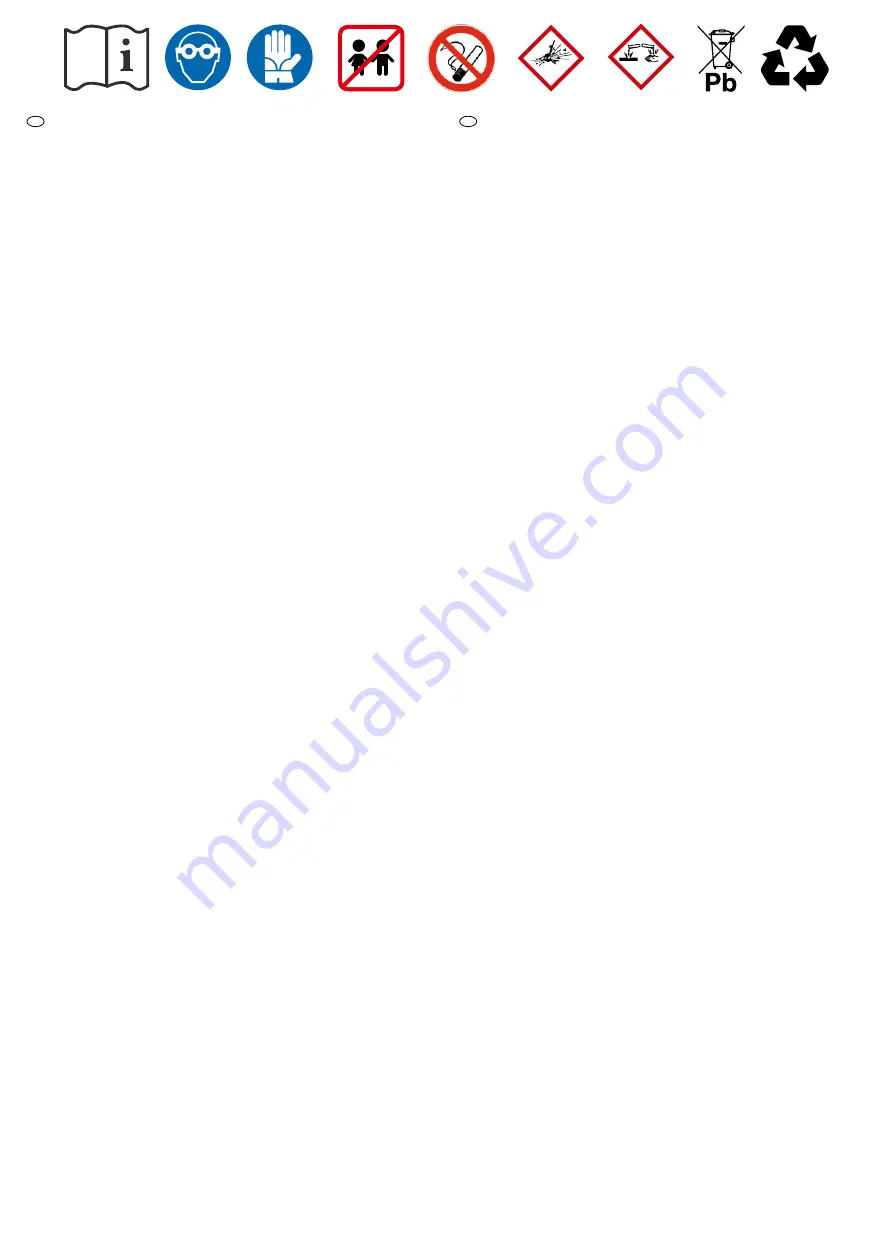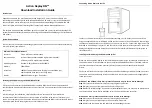
EN
• Read and follow these instructions, and keep them for future reference along
with the operating instructions for the electric fence unit. • Please always wear eye
protection when handling the battery. • Keep children away from batteries.
• No smoking! Keep open flames or sparks away from the area of the battery.
• Danger of explosion! Batteries emit an explosive gas mixture. • Handling the
battery can lead to serious chemical burns. Protect your eyes, hands and clothing.
• The battery contains lead and must be handed over for recycling. Please never
dispose of it in household waste. • Total discharge voids the warranty. • When not
in use, recharge on a monthly basis. • recharge the battery with a suitable charger
The symbols on the battery indicate safety information. Improper handling of the
battery can lead to a hazard and safety risk. Immediately seek medical attention
if acid comes into contact with eyes. If battery acid is swallowed, drink plenty of
water and avoid vomiting. Immediately seek medical attention! If contact with the
skin or eyes occurs, rinse immediately with plenty of water for several minutes. If
acid splashes on clothing, rinse immediately with soapy water and use soda, for
example, to neutralise the acid. Batteries can form an explosive mixture of oxygen
and hydrogen. Any spark, electrostatic discharge included, can ignite these gasses.
Always use antistatic cloths and insulated tools when handling the battery and
during installation.
Recharging the AGM battery
1. Use a voltmeter suitable for a 12 volt battery (min. 2 decimal places) and check
the voltage.
2. If the voltage is under 12.45 volts, connect a suitable charger to the battery. We
recommend using chargers with an automatic characteristic curve (e.g. Kerbl
item no.: 371017/011, Cetek, 4-Load or similar). The use of regular chargers with
a WA characteristic curve is not recommended because the batteries must be
monitored during the charging process.
When connecting or disconnecting, the following procedure should be followed
(charging):
a. Always ensure adequate ventilation and wear protective clothing (goggles,
apron, gloves)
b. Connecting: connect the positive terminal first, then the negative terminal.
c. Switch on the charger
d. Disconnecting: switch off the charger after charging.
Disconnect the negative terminal first, then the positive terminal
3. The battery must first be fully charged before it can be reinstalled or sold to the
customer.
Note:
This procedure is very time-consuming, but it helps to prevent complaints.
Complaints due to improper handling, opening the battery or similar will be rejected.
IT
• Leggere e seguire le istruzioni e conservarle insieme al manuale d‘uso
del‘apparecchio per recinzioni elettrificate. • Indossare tassativamente una protezio-
ne per gli occhi ogni volta che si manipola la batteria. • Tenere i bambini a distanza
dalle batterie. • Vietato fumare! Evitare fiamme libere o scintille in prossimità della
batteria. • Pericolo di esplosione! Le batterie rilasciano una miscela di gas esplo-
siva. • La manipolazione della batteria può causare fenomeni corrosivi di grave
entità. Proteggere gli occhi, le mani e gli indumenti. • La batteria contiene piombo
e deve essere conferita a un centro di riciclo. Non smaltire nei rifiuti domestici.
• La garanzia decade in caso di scaricamento completo. • In caso di inutilizzo
ricaricare una volta al mese. • ricarica della batteria con un caricatore adatto
I simboli sulla batteria mostrano le avvertenze di sicurezza. Una manipolazione
scorretta della batteria può risultare pericolosa e comportare rischi per la sicurezza.
In caso di contatto dell‘acido con gli occhi consultare subito un medico. In caso
d‘ingestione di acido della batteria, bere molta acqua e non indurre il vomito.
Contattare il medico del pronto soccorso! In caso di contatto con la pelle o con gli
occhi, lavare subito per alcuni minuti con abbondante acqua. In caso di spruzzi di
acido sugli indumenti, lavare subito con acqua e sapone ed eventualmente soda per
neutralizzare l‘acido. Nelle batterie può prodursi una miscela esplosiva costituita da
ossigeno e idrogeno. Ogni scintilla, incluse le scariche elettrostatiche, può causare
l‘innesco di questi gas. Utilizzare sempre panni antistatici e utensili isolati durante
la manipolazione della batteria e l‘installazione.
Ricarica della batteria AGM
1. Procurarsi un voltmetro adatto per le batterie da 12 Volt
(min. 2 cifre decimali) e controllare la tensione.
2. Se la tensione è inferiore a 12,45 Volt, collegare la batteria a un caricabatterie
idoneo. Si raccomanda l‘uso di caricabatterie con curva caratteristica automa-
tica (p. es. Kerbl cod. art. 371017/011, Cetek, 4-Load o simile). L‘impiego di
caricabatterie convenzionali con curva caratteristica Wa è sconsigliato, poiché
richiedono che la batteria sia sorvegliata durante l‘operazione di carica.
Nel collegare e scollegare i morsetti attenersi alla seguente procedura
(procedimento di carica):
a. Accertarsi sempre di un‘aerazione sufficiente e indossare abiti protettivi (occhi-
ali, grembiule, guanti)
b. Collegare i morsetti: prima collegare il polo positivo, quindi il polo negativo.
c. Accendere il caricabatteria
d. Scollegare i morsetti: al termine della carica spegnere il caricabatterie.
Staccare prima il polo negativo, poi il polo positivo
3. Solo quando la batteria è completamente carica può essere inserita o venduta a
un cliente.
Nota:
Questa procedura richiede molto tempo, ma serve a prevenire i reclami. Reclami
a causa di una gestione scorretta, dell‘apertura della batteria o simili verranno respinti.
Albert Kerbl GmbH
Felizenzell 9 84428 Buchbach, Germany www.kerbl.com
441203=441204=441250=636441250=BA_12V
-A
GM_Batterien_1216




















